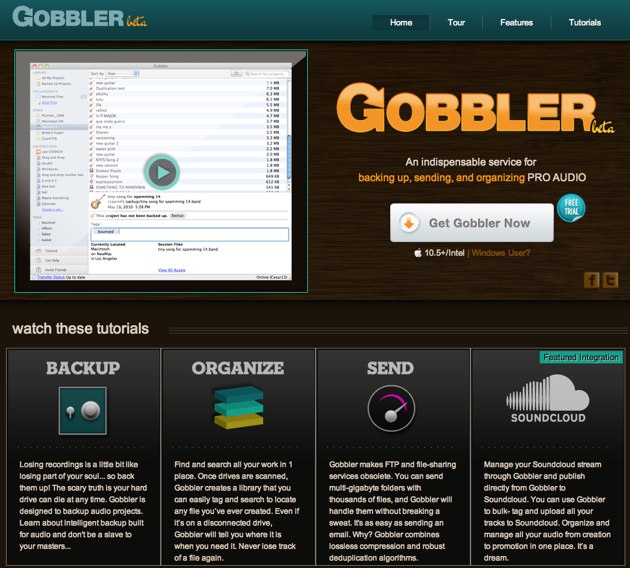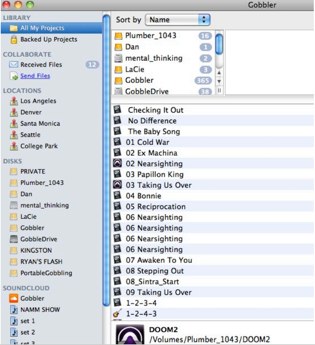
If you’ve ever worked on a big music or video project you’ll probably love Gobbler immediately. Just don’t get too excited – it’s still in early beta and for now all they’ve released is their audio product. The company first debuted publicly at the Launch conference last month, but seems to have attracted almost zero notice from the press until now.
But users have definitely noticed Gobbler. Feedback on their first project is so intensely positive, says CEO Chris Kantrowitz (who cofounded Gobbler with his sister, former MySpace exec Jamie Kantrowitz), that the company is accelerating plans to support video. It should be here by summer.
So what is Gobbler? First it’s desktop software that keeps your media projects organized. Gobbler will locate all of your projects across your various internal and external hard drives, and then keep track of them. Even when you disconnect that external drive, Gobbler knows the project is there and keeps showing it in the file system. That alone makes Gobbler incredibly useful for people who keep grabbing new hard drives to store their terabytes of photo, video and audio projects. Do you even know where all your photos are? I don’t. A lot of them used to be on Flickr, but my pro account lapsed and Yahoo is holding them hostage until I pay up. But that’s another story.
Second, Gobbler will back up your projects to their cloud, powered by Amazon Web Services. And it’s also hyper intelligent. When a new version of a project is created, for example, Gobbler knows it only has to upload, and restore, the tiny number of files that were changed. In a multi-gigabyte project (as we regularly see for TechCrunch video projects), that’s a really big deal.
Finally, Gobbler lets people collaborate on project much more easily than before. FTP just isn’t a good solution for sending 5 gigabytes back and forth. It and other online solutions are so cumbersome that people often just fedex actual hard drives. It’s easier, and quicker.
 But the way Gobbler manages and stores data makes it all a lot simpler, at least after the first upload/download. In fact, the more people are collaborating and sending files back and forth, the quicker Gobbler becomes because most of the files are already on all the various user computers and in the cloud. Chris explains:
But the way Gobbler manages and stores data makes it all a lot simpler, at least after the first upload/download. In fact, the more people are collaborating and sending files back and forth, the quicker Gobbler becomes because most of the files are already on all the various user computers and in the cloud. Chris explains:
When whole projects have to be sent back and forth between collaborators the only thing being sent are new and updated files. How does this work? If you and are are working together and i have shared the my project with you. you have downloaded it you make a bunch of data and want to send it back to me. There is a high likelihood the other thing that has changed is data in the source project file. When you go to send the project back to me we will upload the new or changed data only. The efficiency is the cloud sits in the middle and knows what is contained in each project AND Gobbler knows what is being stored locally. So it can reassemble projects via data which is found locally and in the cloud. Here is where it gets really neat. Let’s say had a bunch of files from a previous project you were using with a whole new project you incorporate those old files in the project and add a bunch of new ones… when you go to send this project all you will be sending is the new stuff, gobbler will see the fils as having already been in the system and will note that they are associated with the new projects as well.
It all seems like common sense, of course, and startups like DropBox have been smart about not re-uploading redundant files for online storage for some time. But as far as I can tell, no one has been so intelligent about file management on both the upload and download side. The fact that Gobbler is desktop software makes all this possible.
The company also (carefully) compresses audio files to ease bandwidth issues. They use open source FLAC for compression, and have added their own metadata layer that follows projects/files around the Gobbler ecosystem. They plan to expand the types of metadata they’re storing to include deeper information about the project for long term archiving, says the company, using standards like the METS schema.
All in all this is a really useful and tidy product that may become indispensable to the 6 million music makers, 12 million pro and prosumer photographers and 3 million videographers out there in the world. We’ll almost certainly be using Gobbler as soon as the video product comes out, and I may use it personally for photo management.
The company quietly raised, but never announced, $1.3 million from Dave Goldberg, Sky Dayton and Tim Wyatt in January. They’re raising a new round immediately to help deal with all the user demand, they say, and to speed development of the video product.
As an aside, this is just another example of how amazingly efficient platforms like Amazon Web Services are. Once you’ve properly built your product it just scales effortlessly as users flock to the service. In the old days it would have taken tens of millions of dollars on the operations side and many months to scale quickly. I wonder how Friendster would have turned out if they hadn’t crashed and burned as they tried to deal with too many users.